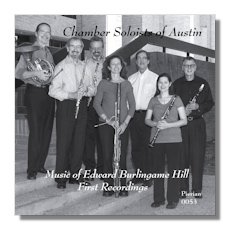
The Internet's Premier Classical Music Source
Related Links
- Latest Reviews
- More Reviews
-
By Composer
-
Collections
DVD & Blu-ray
Books
Concert Reviews
Articles/Interviews
Software
Audio
Search Amazon
Recommended Links
Site News
 CD Review
CD Review
Edward Burlingame Hill

Chamber Works
- Sonata for Flute & Piano, Op. 31 *
- Idyl, Elegy and Scherzo for Flute & Piano *
- Four Pieces for Wind Instruments (1928)*
- Sextet for Flute, Oboe, Clarinet, Horn, Bassoon & Piano, Op. 39 (1934)
Chamber Soloists of Austin
* First Performances
Pierian Recording Society 53 63:54 2015
Edward Burlingame Hill was one of the first American composers to study in Paris – well before the time of Copland and Nadia Boulanger – and he wrote a book in 1924, Modern French Music, going back to Franck, including Debussy, Ravel and Satie, and up to Roussel, Poulenc, and others. He became a Harvard professor and taught many famous American composers, quite a few of whom who went to Paris themselves. Hill's compositions were influenced by French styles, even in his later career, but his musical development went through several styles including jazz and neoclassicism. My book, Neoclassical Music in America: Voices of Clarity and Restraint, includes a short chapter on Hill.
The two works for flute and piano on this disc are perhaps a world apart from the two sextets, for winds alone, and for winds plus piano.
The delightful Sonata for Flute and Piano (1925), in four movements totaling nineteen minutes, opens with cheery, upbeat, birdlike melody. The first movement, Allegro moderato e semplice, is followed by a Quasi Minuetto (Allegretto giocoso) in a similar mood. The third, and longest movement, Andante tranquillo, is indeed tranquil, but may be heard as a bit plaintive also. The finale, Molto vivace, is lively and upbeat again, with especially vigorous playing from the piano.
The Idyl [sic], Elegy and Scherzo for Flute and Piano (1921-1922), its three movements named in its title not quite totaling twelve minutes in duration, begins with a short, gentle movement (Allegro grazioso). The lovely and fresh Elegy which follows is also gentle, if pensive.
The third – and final movement, unusually designated Scherzo – Allegro, is lively, like the Sonata, melodic, and contains a change of pace within its four and a half minute duration.
The Four Pieces for Wind Instruments is a wind sextet, scored like the final piece here, but with a second clarinet instead of a piano, and sharing a complexity with that work, is only eight minutes in duration. The short Prelude is melodic, and includes some counterpoint, as does the succeeding Quasi Minuetto, the form surely a neoclassical touch. The brief Scherzino is chirpy. The final, and longest, movement is an Elegy, with legato contrapuntal lines, and a prominent three-note ostinato on the horn.
The twenty-five minute Sexte tis a significant work, the only one previously recorded, and I confess it took me a number of hearings to get a handle on it. I first heard some early rehearsals in Austin, as well as rehearsals and the premiere of Hill's Fourth Symphony, and even with a score in front of me, I did not quite grasp the Sextet's structure. After listening to this recording repeatedly I have come to appreciate the work highly, especially the long slow movement.
The Sextet's opening movement, Allegro non troppo, ma giocoso, opens and closes with a lively theme. As it proceeds, the flute horn and piano stand out successively, especially the horn. The cheerful Molto vivace second movement has some interesting harmony and varied tempo. Then comes the movement designated as Lento con duolo, which I hear as the heart of the piece. It opens with a funeral march pace, a slow heavy tread marked by the piano. This segues into a declamatory passage, before the flute brings a gentler mood. The horn continues to lament, however. The piano then asserts a sense of relief and before the end the mood is more elegiac than funereal. This movement is a powerful one. The finale, Allegro giusto, represents a vigorous recovery from the dolorous mood of the preceding. The flute makes cheerful melody and the bassoon chugs along in a pleasant way. The horn leads the way to a rising mood, which at the end is triumphant over the darker mood.
Strongly recommended.
Copyright © 2016, R. James Tobin




















